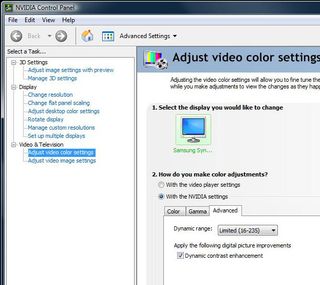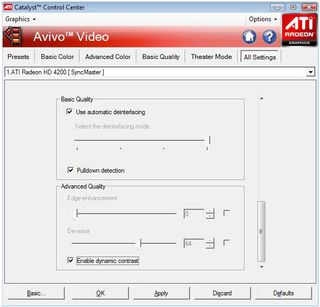Blu-ray Done Right: How Does Your Integrated GPU Stack Up?
Dynamic Contrast And Color Enhancements: AMD Versus Nvidia
Nvidia has implemented dynamic contrast and color enhancements since the beginning of last year on all GeForce 9-series cards, in addition to higher-end GeForce 8-series cards. It is only now that AMD has caught up by releasing similar features.
What are these features for? The idea is that during de-saturated or low-contrast scenes, the driver will automatically boost the contrast and color saturation in order to make the image as vivid as possible.
On the surface, this sounds like a great idea, until you realize that contrast and color are two areas that directors and other film professionals spend countless hours perfecting. Every scene has a lot of thought put into it, with conscious decisions applied to how things look in order to draw a precise mood and feeling from the viewer. Once a movie is mastered, the contrast and color settings are far from a haphazard mistake that needs to be fixed.
To put it in perspective, imagine watching Batman: The Dark Knight with happy, bright oversaturated colors. It just wouldn't work. The movie was designed with a gritty, de-saturated feel for a certain effect, and brightening it up with color doesn't suit the mood.
With this in mind, our recommendation would be to have your television calibrated properly in order to enjoy your movies the way they were truly meant to be seen. Having said that, there are folks who enjoy the over-bright, over-saturated look to which we're exposed in electronics stores. In addition, these enhancements might prove useful if you watch older films of poorer quality. For folks who might want to use them, let's have a short look at how these features work.

We'll begin with the GeForce boards, since they had a solid head start in implementing the dynamic contrast feature. Now, the GeForce 8200 chipset doesn't support this capability, but the GeForce 9300/9400 does, so that's the platform with which we'll work.
We did experience a slight problem with the GeForce drivers in that we couldn't find the feature in the 190.38 package. We had to revert to an older driver set to test dynamic contrast (version 178.13). Apparently, this problem isn't unheard of, and switching to other drivers can sometimes rectify it. But if you're big on using the feature, it might be a pain.
Stay on the Cutting Edge
Join the experts who read Tom's Hardware for the inside track on enthusiast PC tech news — and have for over 25 years. We'll send breaking news and in-depth reviews of CPUs, GPUs, AI, maker hardware and more straight to your inbox.

AMD's version of dynamic contrast has an interesting limitation in that it can only be enabled when noise reduction is turned off. This means that when dynamic contrast is enabled, the Radeon HQV HD video-quality score drops from 80 to 55 in one fell swoop. In its presentation, AMD also suggests that the dynamic contrast option will negate both the detail-enhancement option and HD Pulldown. But when we tried it out, HD Pulldown seemed to work without issue.
Current page: Dynamic Contrast And Color Enhancements: AMD Versus Nvidia
Prev Page Power-Usage Benchmarks Next Page Conclusion-
Proximon Great article. I think maybe the 4650 is a bit overkill, but that's just nitpicking.Reply
As long as you are talking about HTPC builds though, you might want to mention temps... aren't the 9300/9400 boards very hot? -
epsiloneri Power draw is not interesting because of the electricity bill, it is the generated heat needed to be dissipated with the associated noise levels due to cooling that is critical for an HTPC.Reply
-
HalfHuman i don't get it why a home theater would use a 1200w power source. at the same time i don't get why would someone evaluate the power efficency using this kind of power sorce. if you ask me i'd make this crazy ass power supplies illegal. a normal hometheater should not use more than 50w at idle and 100-150w at load. seems that this is what these actually consume. factor in the less than 5% load on the power supply and you get a masterfull 50-60% power efficency. i'd love to see some proper power supply test.Reply -
falchard BTW, I would like to see a "Can it play Crysis" article in the future that runs down every video card and IGP, then determines if it can possibly play Crysis and at what settings.Reply -
HalfHuman the 1200w power supply is green as in blue-green mould green.Reply
this is in fact an excellent power supply... if you use it. at 100watts load it has a "cool" 76% efficency. if the intel pc uses less than 82watts in load and 66watts in idle you can only imagine the efficency a power supply has at below 5% load. the site suggest around 65% so instead of having a proper power supply using 40watts or less when idle, you get this "green" efficient hummer who swollows 66w. i really like you articles guys but this kind of testing is not the way to go. -
Efficiency isn't even tested below 20% load i believe But it should still be around 70-80% it is a Thermaltake Toughpower 1200w and all of them(3 listed on their site) are standard 80% eff rated or bronze. Ture a more modest Delta,Seasonic 250w or 300w would be much more appropriate for a htpc.Reply
-
HalfHuman 20% for this would be 240watts and efficency would still be reasonable.Reply
i posted some link but i see it's been removed. that review said something about 65% minimum. -
drew_a Uh, guys... you might want to edit this article...Reply
"For the last CPU utilization test, we will check the capability of these graphic chipsets to accelerate picture-in-picture (PIP) video streams. To do this, we will use the Blu-ray dick Sunshine, which utilizes the H.264 codec and features PIP commentary during playback."
on page 6 -
icepick314 "If you are an audiophile, you should know that out of these remaining options, only the GeForce 9300/9400 can handle uncompressed eight-channel LPCM audio over HDMI 1.3."Reply
i did NOT know this...
i thought only way to listen to uncompressed audio on blu-ray was using Asus Xonar HDAV 1.3 audio card to bitstream to your receiver...
it's nice to know that IGP has enough power to handle 1080p while streaming HD audio codec....
Most Popular

